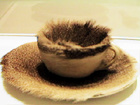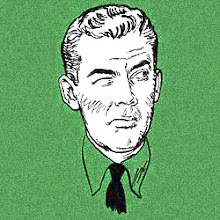 In the rapidly commercializing field of contemporary art, he was a more and more visible presence. He served on exhibition juries, gave interviews, organized and installed the Surrealist group show at D'Arcy Gallery which has already been mentioned here, and accepted invitations to lecture about his work, a feat he discovered he could manage easily. In '60 he was elected to the National Institute of Arts and Letters (amazing, when you think of how staid that organization was).
In the rapidly commercializing field of contemporary art, he was a more and more visible presence. He served on exhibition juries, gave interviews, organized and installed the Surrealist group show at D'Arcy Gallery which has already been mentioned here, and accepted invitations to lecture about his work, a feat he discovered he could manage easily. In '60 he was elected to the National Institute of Arts and Letters (amazing, when you think of how staid that organization was). "I'm nothing else but an artist, I'm sure," he said in '61 in a filmed interview for the BBC, "and delighted to be.... The years change your attitude, and I couldn't be very iconoclastic any more." I haven't seen the film, but reading this in print it strikes me that he couldn't have been serious in saying this, however much things had changed. He changed his anti-art rhetoric somewhat, but more, it seems, to suit the times than to express a major change in himself. At a symposium at MOMA (an event that was part of William Seitz's huge "Art of Assemblage" exhibition), he was asked, "Did you, or do you, really want to destroy art?" Duchamp's answer was: "I don't want to destroy art for anybody else but myself, that's all."
Among the sources: Calvin Tompkins, Duchamp, 1996.

 Is '60 the moment when the end of the end of the Old Left had been reached and the New Left began to emerge? Is it the final ascendancy, in certain scenes at least, of poetic postmodernity? Surely the publication of Donald Allen's The New American Poetry that year suggests this, but then again--once again--we look back on "New" here and see continuity. The rhetoric of the Kennedy-Nixon contest made much less of a dent than everyone (at the time as well as since) claimed, so one wonders why were such great claims made?
Is '60 the moment when the end of the end of the Old Left had been reached and the New Left began to emerge? Is it the final ascendancy, in certain scenes at least, of poetic postmodernity? Surely the publication of Donald Allen's The New American Poetry that year suggests this, but then again--once again--we look back on "New" here and see continuity. The rhetoric of the Kennedy-Nixon contest made much less of a dent than everyone (at the time as well as since) claimed, so one wonders why were such great claims made?  Had we come to expect "1960" to be truly ubiquitously modern in a way that the 1950s really were not--not quite? And what specifically does "modern" mean in the Kennedyesque talk then and now about the torch being passed to a new generation, etc.? The First Lady really meant "modernist" when Camelotians said "modern." What about the others across the new young cultural leadership? I've been surprised by how frequently the
Had we come to expect "1960" to be truly ubiquitously modern in a way that the 1950s really were not--not quite? And what specifically does "modern" mean in the Kennedyesque talk then and now about the torch being passed to a new generation, etc.? The First Lady really meant "modernist" when Camelotians said "modern." What about the others across the new young cultural leadership? I've been surprised by how frequently the  "Beat movement" was covered in 1960 in the mainstream press. I was expecting a fair measure but I've found tonnage. 1960 was the year when the figure of the beat was beginning to find acceptance, although still 80% of these stories are mocking, rebels-without-cause condescension. For anyone whose analysis made an impact nationally, do these antipolitical adolescents count as part of the "new young cultural leadership"? No, but rather than the two being opposites, they fall along a Continuum of the New American. Now that's a change for '60.
"Beat movement" was covered in 1960 in the mainstream press. I was expecting a fair measure but I've found tonnage. 1960 was the year when the figure of the beat was beginning to find acceptance, although still 80% of these stories are mocking, rebels-without-cause condescension. For anyone whose analysis made an impact nationally, do these antipolitical adolescents count as part of the "new young cultural leadership"? No, but rather than the two being opposites, they fall along a Continuum of the New American. Now that's a change for '60.







